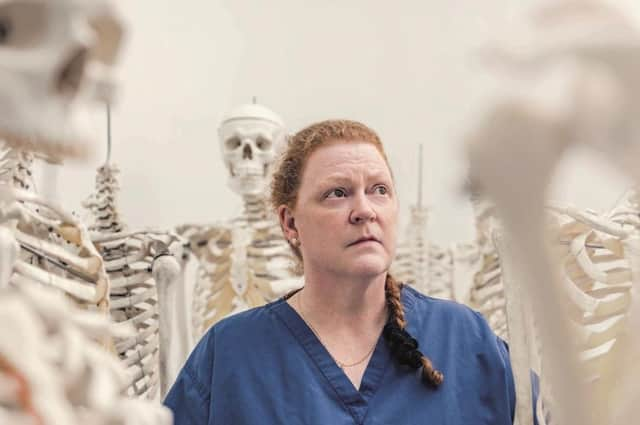Book review: Written In Bone, by Sue Black


I don’t know why culture has taken a morbid turn, but I seem to have spent an inordinate time recently among the dead. My last four reviews for these pages have comprised Denise Mina’s novel about the cold case murder of a prostitute, Peter Ross on graveyards, Lauren Beukes imagining an even worse pandemic and Neil Oliver’s less than impressive “wisdom” book about archaeology. Even my guilty pleasure, a new Doctor Who novel by Steve Cole is called Time Lord Victorious: The Knight, The Fool And The Dead, and I’ve been watching the German series 23 Deaths and, like a lot of other people, Des. Thank goodness I managed to squeeze in Ben Schott’s syllabub of Wodehouse homage, Jeeves And The Leap Of Faith, or I would have concluded this game isn’t worth a candle. Now along comes Sue Black, with a sort of sequel, subtitled “Hidden Stories In What We Leave Behind”, to her Saltire Prize winning All That Remains. She is, of course, a respected forensic anthropologist, so don’t expect this to be kitten memes and candy-floss.
It is a curious hybrid of a book, and probably the better for it. In part, it is a beginner’s guide to our skeletal anatomy, and as such is structured in the way a forensic anthropologist might go about piecing together remains. Therefore it begins with the cranium and moves through face, spine, chest, throat, the pectoral and pelvic girdles, arms and legs, hands and feet: all together children – heads, shoulders, knees and toes.
Advertisement
Hide AdThis material is written with clear expertise and lucidity. But the book isn’t a medical primer, since it will also appeal to aficionados of true crime, in that to explain her work and our bodies, she discusses various cases of note. These are both contemporary and historical, including The Monster of Terrazzo and the murderous doctor “Buck Ruxton”; the corpse of Lord Lovat and the murder of Maurice Bishop, leader of the New Jewel movement in Granada; the Dundee man suspected of being Jack the Ripper and Richard Huckle, “the UK’s most prolific paedophile”.
There are two further strands to the book. One part deals with Black’s involvement with other professionals, such as the police, lawyers for both the defence and the prosecution, pathologists and other experts in her field. This is perhaps the most interesting theme, in that she unpicks all the biases, false leads, rhetorical strategies and media hyping that surround such work. We have heard a lot about “following the science” in recent months, yet Black shows that to be a hard path to do with integrity. Sometimes you have to say “we just don’t know”. On occasion there is a degree of triumphalism in her often feisty exchanges with others, but since it is offset by humility about what we can and can’t know, this is pardonable.
The final strand is some of her most personal writing. Two parts stand out. There is an account, which she has spoken about before, of being the victim of a sexual predator as a child. I may not be able to tell a hyoid from a xiphoid, but I do know how to analyse narratives, and her affecting and terrifying recounting has what we call “the authenticating detail”. It’s nothing more than that she was looking forward to a glass of milk. Ruth Davidson in conversation with Black asked if this childhood trauma was a driving force behind her work on child mortalities and paedophile identification. To her credit, Black says no: but it might be behind a sense of justice. The second instance is almost gallows humour, as she recounts how her own body is to be treated after death. She will be staying at Dundee University, albeit as a rearticulated skeleton to be used for teaching purposes.
There is a lot of incidental humour in the book – a man whose false teeth were not his own, the frequency of “human” hands washing up on beaches that turn out to be seal flippers, the observation that you can live without a leg but not a head. It seems necessary when one is talking about defleshing and the brownish sludge of decayed flesh to have some lightness. But the book also has a moral core. At the outset she states “the dead have a right to privacy”, and she is indignant about Damien Hirst’s diamond-encrusted skull since this was once a person. When confessing to the impossibility of ever coming to conclusions in some cases she writes “I would rather live with hope than scorn”.
She might sometimes take a little too much delight in saying how crime writers for page and screen keep getting things wrong, but again, forgivable. Very few serial killers are geniuses. As she writes “The inexperienced dismemberer, and let’s face it most of us are, will probably first attempt to cut through the long bones”. Written In Bone is a fascinating if grisly book, and as a kind of palate cleanser I then read Paul Nurse’s slim but profound What Is Life, covering the cell, the gene, evolution, chemistry and information. It too ends with cautious optimism. Both should be read.
Written In Bone, by Sue Black, Doubleday, £18.99
A message from the Editor:
Thank you for reading this story on our website. While I have your attention, I also have an important request to make of you.
Advertisement
Hide AdThe dramatic events of 2020 are having a major impact on many of our advertisers - and consequently the revenue we receive. We are now more reliant than ever on you taking out a digital subscription to support our journalism.
To subscribe to scotsman.com and enjoy unlimited access to Scottish news and information online and on our app, visit https://www.scotsman.com/subscriptions
Joy Yates
Editorial Director